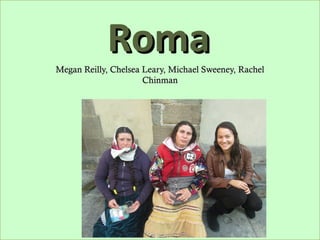
Presentation cc psych
- 1. Roma Megan Reilly, Chelsea Leary, Michael Sweeney, Rachel Chinman
- 2. Introduction http://www.youtube.com/watch?v=hpQQ4A5xRwU (2:15-5:15) Surprisingly, Roma can be considered as the first European people, since they "broke" European borders much before any international treaty or convention existed. They travelled all around Europe enriching European cultural heritage.
- 3. Where do they come from? Today scholars agree that the origins of the Roma people were established in western India, and they began to spread slowly across Eastern Europe over the centuries. Now Roma are beginning to flood in to France, and Italy from nations such as Romania, and the czech republic.
- 4. Cont… As the Roma people suffer extreme injustice as try to find a permanent new home throughout Europe. They are in a consist state of fear that inevitably leds to travel in hope for salvation and acceptance by the majority of any culture.
- 5. The Roma Population in Europe Czech Republic 250,000 to 300,000 Romania 1,800,000 to 2,500,000 Hungary 550,000600,000 France 280,000 to 340,000 Italy 90,000110,000
- 6. Do they have friends outside the Roma community? ‘go back to your own country, where you belong.” Due to their nomadic lifestyle and differences in language and culture, and the negative stereotypes by host nationals it becomes in general extremely difficult for older Roma to adapt, and make friends in a new culture.
- 7. Cont… Younger Roma are much more likely to adapt to their new host culture by learning the language, living in both Roma and the host national culture since youth and making more meaning full interactions on a daylily basis due to the lack of language barrier.
- 8. Where do they work/live in Florence? Most of them live in camps that embody the worst stereotypes in Europe lack proper sanitation (most don’t have toilets or showers) 8 camps around/within Florence: one is a permanent structure, two are considered temporary facilities and five are abusive and filled with squatters 1 camp--permanent walled structures, the rest are a combination of campers, mobile homes, and temporary barracks Largest employment sectors in Florence: precarious work (42%), selling flowers(35%) and work with social cooperatives(18%)
- 9. Are they religious? The Roma women we interviewed all claimed to be religious- Catholic Churches: Sante Croce, a church in Piazza Liberta Statistically most Roma are either Catholic or Eastern Orthodox There are rumors of their practice of “white magic” which uses nature and the elements, but we are not sure how prevalent this is Some are Jehova’s Witness
- 10. What are the Roma youth like? 46 out of 104 kindergarten aged children do not attend school at all. This number increases progressively with age. Children leave school at a young age – care for younger siblings/beg for a living Gypsy girls forced to leave school when they become old enough to marry (13-17) With lack of schooling the children find it difficult to procure employment when they are older contributes to heightened criminal activities
- 11. Why do they come here? Find that tourists give them more money than they will get from a real job Some can’t get a real job because they don’t have working papers For jobs that involve serving customers, the employers discriminate and don’t hire them
- 12. Who do they interact with? Mostly with each other Only others when they are begging for money Most don’t talk to people outside of the Roma community
- 13. Do they feel safe? According to our interviews, they do feel safe, but according to our research we don’t see how they can since the government is trying to get rid of the Roma altogether Roma camps are sometimes ambushed by people who don’t want them to be around anymore
- 14. 0:11
- 15. It took a while to get them to cooperate without giving much money in exchange The one on the left was much more willing to talk Enjoyed students being interested in them
- 17. Has 3 children- one 9 year old in school in Florence who does gymnastics and plays soccer Romani brought physical culture back into Europe upon their mass migration, including acrobatics, gymnastics, and dance Direct link between the European Gymnastics traditions and the Indian Yogic traditions She tried to have a conversation with us and hardly begged us for more money Wanted us to meet her American friend who is 32 years old
- 18. Do they have a family? Most do. Gypsy girls normally marry between 13-17 years-old and quickly start a family. They’re known to be very family oriented. A large amount of the family’s earnings come from what the children can bring home. They are also known to have very large families.
- 19. How do they feel they’ve been treated? The Italian government’s lack of action in the area of Gypsy politics both reflects and impacts national public attitudes towards Gypsies. Gypsies in Italy are denied of rights (Roma workers are refused jobs, their children are refused places in school) The criticisms of gypsies in Italy include: discrimination in housing and employment, violence and intimidation, unprofessional police behavior, the role of the media in diffusing negative stereotypes, and the lack of support for human rights in the Italian justice system. They receive very little attention both politically and academically. Gypsy children are often unfairly prevented from enrolling in European schools.
- 20. Do they feel they have adapted? The Roma have a saying "roma romesa a gadjo gadjesa" which roughly translates into: the Roma stick with the Roma and the gadjo stick with the gadjo (non-Roma). They cherish their ethnicity and culture to the point where integration isn't usually wanted. Lack of education and economic opportunities lead to social problems for the Gypsies. Ostracized in Italy culturally as well as socio- economically.